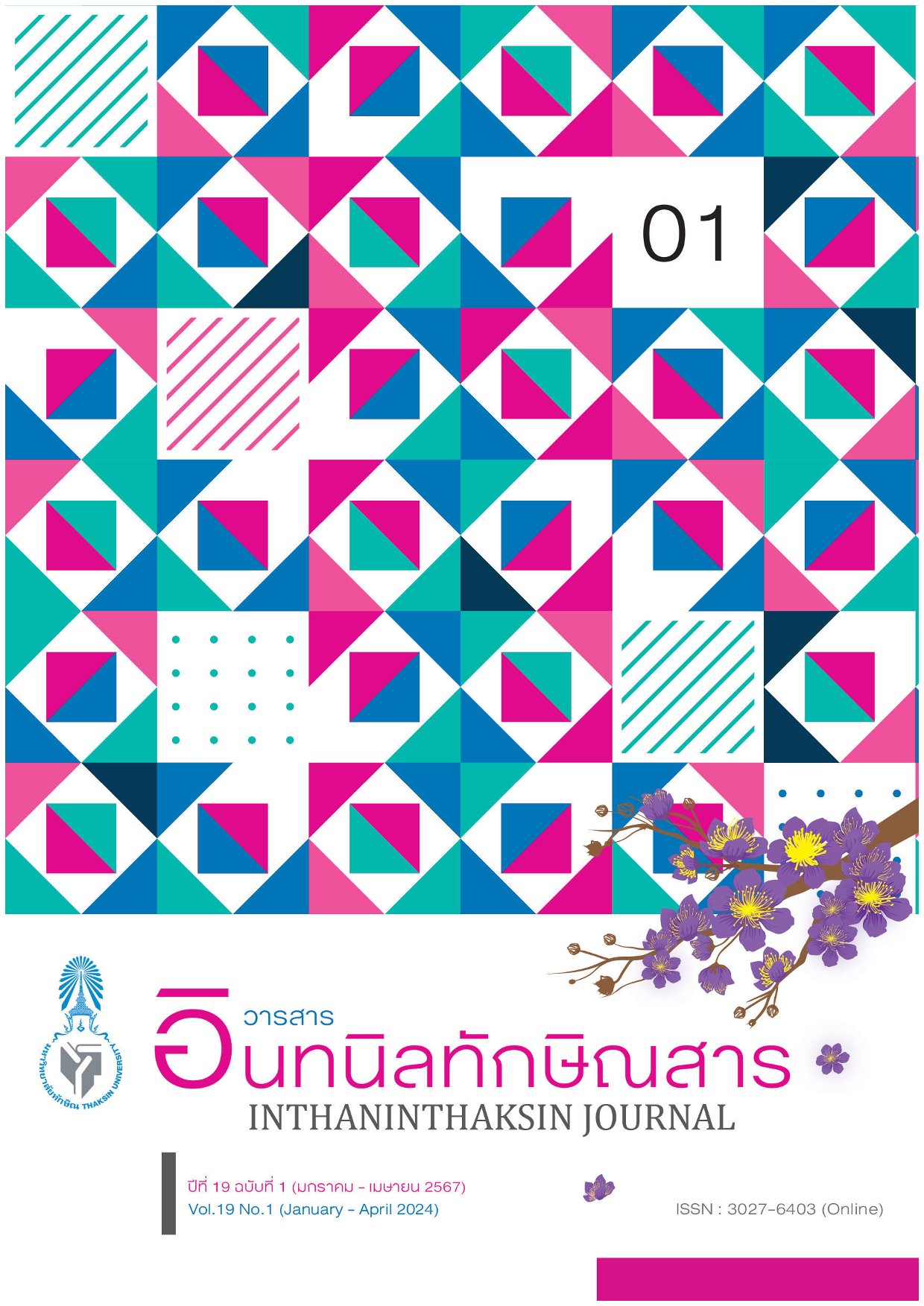ผลของการใช้รูปแบบการเรียนรู้แบบผสานวิธีที่มีต่อทักษะการพูดภาษาอังกฤษของนักศึกษาที่ใช้ภาษาอังกฤษในฐานะภาษาต่างประเทศ ในบริบทของภาษาอังกฤษในฐานะภาษากลางของโลก
Main Article Content
บทคัดย่อ
This research aimed to investigate the effects of the blended learning model on EFL students’ speaking skills in the context of English as a lingua franca and to survey their opinions on learning through the model. The participants were twenty first–year students who studied accounting and enrolled in an English for communication course in the first semester of the academic year 2021 at That Phanom College, Nakhon Phanom University. The instruments for conducting this research were the blended learning model, lesson plans, tests of speaking skills in the context of English as a lingua franca, and the questionnaire on the opinion towards learning through blended learning model. The findings indicated that the students’ scoring level of speaking skills in the context of English as a lingua franca was significantly higher after learning through the blended learning model. Besides, their opinion towards learning through blended learning model was positive in all aspects: contents of the model, activities of the model, media and tools of the model, and the usefulness of the model for developing speaking skills in the context of English as a lingua franca.
Article Details

อนุญาตภายใต้เงื่อนไข Creative Commons Attribution-NonCommercial-NoDerivatives 4.0 International License.
เอกสารอ้างอิง
Allan, B. (2007). Blended learning: Tools for teaching and training. London: Facet Publishing.
Allen, I. E., and Seaman, J. (2006). Blending in: The extent and promise of blended education in the United States. In A. G. Picciano & C. D. Dziuban (Eds.), Blended learning: Research perspectives. Needham, MA: Sloan Center for OnLine Education (SCOLE).
Baker, W. (2009). The cultures of English as a lingua franca, TESOL Quarterly. 43(4), 567-592.
Bataineh, R. (2017). The utility of blended learning in EFL reading and grammar: A case for Moodle, Teaching English with Technology. 17(3), 35-49.
Biyaem, S. (1997). The Child Concept of Story. Illinois: University of Chicago.
Press. Branch, R.M. (2009). Instructional Design: The ADDIE Approach. Springer: New York.
Cogo, A. and Dewey, M. (2006). Efficiency in ELF communication: From pragmatic motives to lexico-grammatical innovation, Nordic Journal of English Studies. 5(2), 59–93.
Dawley, L. (2007). The tool for successful online teaching. London: Information Science Publishing.
Foley, J. A. (2005). English in Thailand, RELC Journal. 36(2), 223-234.
Foley, J. (2007). English as a global language: my two Satangs' worth, RELC. 38(1), 7-17.
Graham, C.R. (2006). Blended learning system: definition, current trends, and future Directions, In C.J. Bonk and C.R. Graham (Eds.), Handbook of Blended Learning: Global Perspectives, 3 – 21. San Francisco, CA: Peiffer Publishing.
Gilakjani, A.P. and Ahmadi, M.R. (2011). A Study of Factors Affecting EFL Learners' English Listening Comprehension and the Strategies for Improvement, Journal of Language Teaching and Research. 2(5),977-988.
Heinich, R., Molenda, M., Russell, J. D., and Smaldino, S. E. (2001). Instructional media and technologies for learning (7th ed.). Englewood Cliffs, NJ: Prentice Hall.
Hinkel, Eli. (2005). Handbook of Research in Secong Language Teaching and Learning. London: Seattle University.
Hinkel, E. (2010). Integrating the four skills: Current and historical perspectives. Oxford: Oxford University Press.
Jenkins, J. (2000). The Phonology of English as an International Language. Oxford: Oxford University Press.
Jenkins, J. (2006). Current perspectives on teaching World Englishes and English as a lingua Franca, TESOL Quarterly. 40(1), 157-181.
Jenkins, J., Cogo, A., and Dewey, M. (2011). Review of developments in research into English as a Lingua Franca, Language Teaching. 44(3), 281-315.
Kachru, B. B. (2005). Asian Englishes : beyond the canon. New Delhi: Oxford University Press.
Kachru, Y. and Smith, L.E. (2008). Cultures, contexts, and World Englishes. New York: Routledge.
Kantisa, P. (2020). Effects of blended learning on Thai EFL university students' speaking ability and learning motivation (Doctoral Dissertation). Bangkok: Thammasat University.
Kirkgoz, Y. (2011). A blended learning study on implementing video recorded speaking tasks in task-based classroom instruction, TOJET: The Turkish Online Journal of Educational Technology. 10(4), 1-13.
Kosar, G. (2016). A study of EFL instructors’ perceptions of blended learning, Procedia – Social and Behavioral Sciences. 232(2016), 736-744.
Lawtie. (2004). Biodiesel and Speech Difficulties. Retrieved July 25, 2023, from http:/www.scips.worc.ac.uk/subjects_and_challenges/biosciences/b iosci_speech.
Lui, C., and Long, F. (2014). The discussion of traditional teaching and multimedia teaching approach in college English teaching. Retrieved July 25, 2023, from https://www.atlantis-press.com/proceedings/icmess-14/11134.
Marsh, D. (2012). Blended learning: Creating learning opportunity for language learners. New York: Cambridge University Press.
Morrison, G.R., Ross, S.M., Kalman, H.K., Kemp, J.E. (2013). Designing Effective Instruction, (7th ed.). Hoboken, NJ: Wiley.
National Identity Board,. (2000). Thailand into the 2000s. Bangkok: Office of the Prime Minister.
Richards, J.C. and W.A. Renandya. (2002). Methodology in Language Teaching. Cambridge: Cambridge University Press.
Rost, M. (2002). Teaching and Researching Listening. London: Longman.
Seidlhofer, B. (2011). Understanding English as a Lingua Franca. Oxford: Oxford University Press.
Selinger, M. (2008). Communication technology in schools. Retrieved July 27, 2023, from http://www.imfundo.org/papers/cit-in-s.doc.
Soler, R. (2017). Subjects in the blended learning model design: Theoretical and methodological elements. Procedia - Social and Behavioral Sciences, 237(1), 771-777.
Stein, J., and Graham, R.C. (2014). Essentials for blended learning. New York: Routledge.
Ur, P. (1998). A course in language teaching. United Kingdom: Cambridge University Press.


